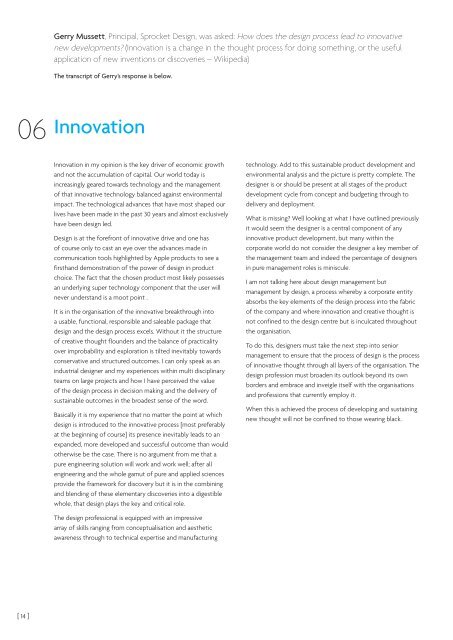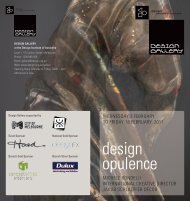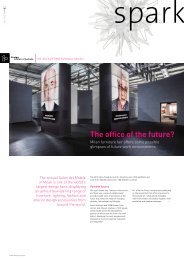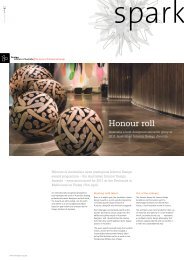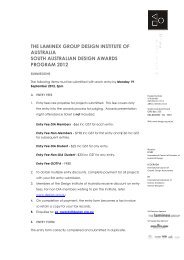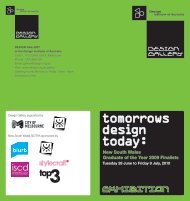Launch Report - Design Institute of Australia
Launch Report - Design Institute of Australia
Launch Report - Design Institute of Australia
You also want an ePaper? Increase the reach of your titles
YUMPU automatically turns print PDFs into web optimized ePapers that Google loves.
Gerry Mussett, Principal, Sprocket <strong>Design</strong>, was asked: How does the design process lead to innovative<br />
new developments? (Innovation is a change in the thought process for doing something, or the useful<br />
application <strong>of</strong> new inventions or discoveries – Wikipedia)<br />
The transcript <strong>of</strong> Gerry’s response is below.<br />
06<br />
Innovation<br />
Innovation in my opinion is the key driver <strong>of</strong> economic growth<br />
and not the accumulation <strong>of</strong> capital. Our world today is<br />
increasingly geared towards technology and the management<br />
<strong>of</strong> that innovative technology balanced against environmental<br />
impact. The technological advances that have most shaped our<br />
lives have been made in the past 30 years and almost exclusively<br />
have been design led.<br />
<strong>Design</strong> is at the forefront <strong>of</strong> innovative drive and one has<br />
<strong>of</strong> course only to cast an eye over the advances made in<br />
communication tools highlighted by Apple products to see a<br />
firsthand demonstration <strong>of</strong> the power <strong>of</strong> design in product<br />
choice. The fact that the chosen product most likely possesses<br />
an underlying super technology component that the user will<br />
never understand is a moot point .<br />
It is in the organisation <strong>of</strong> the innovative breakthrough into<br />
a usable, functional, responsible and saleable package that<br />
design and the design process excels. Without it the structure<br />
<strong>of</strong> creative thought flounders and the balance <strong>of</strong> practicality<br />
over improbability and exploration is tilted inevitably towards<br />
conservative and structured outcomes. I can only speak as an<br />
industrial designer and my experiences within multi disciplinary<br />
teams on large projects and how I have perceived the value<br />
<strong>of</strong> the design process in decision making and the delivery <strong>of</strong><br />
sustainable outcomes in the broadest sense <strong>of</strong> the word.<br />
Basically it is my experience that no matter the point at which<br />
design is introduced to the innovative process [most preferably<br />
at the beginning <strong>of</strong> course] its presence inevitably leads to an<br />
expanded, more developed and successful outcome than would<br />
otherwise be the case. There is no argument from me that a<br />
pure engineering solution will work and work well; after all<br />
engineering and the whole gamut <strong>of</strong> pure and applied sciences<br />
provide the framework for discovery but it is in the combining<br />
and blending <strong>of</strong> these elementary discoveries into a digestible<br />
whole, that design plays the key and critical role.<br />
technology. Add to this sustainable product development and<br />
environmental analysis and the picture is pretty complete. The<br />
designer is or should be present at all stages <strong>of</strong> the product<br />
development cycle from concept and budgeting through to<br />
delivery and deployment.<br />
What is missing? Well looking at what I have outlined previously<br />
it would seem the designer is a central component <strong>of</strong> any<br />
innovative product development, but many within the<br />
corporate world do not consider the designer a key member <strong>of</strong><br />
the management team and indeed the percentage <strong>of</strong> designers<br />
in pure management roles is miniscule.<br />
I am not talking here about design management but<br />
management by design, a process whereby a corporate entity<br />
absorbs the key elements <strong>of</strong> the design process into the fabric<br />
<strong>of</strong> the company and where innovation and creative thought is<br />
not confined to the design centre but is inculcated throughout<br />
the organisation.<br />
To do this, designers must take the next step into senior<br />
management to ensure that the process <strong>of</strong> design is the process<br />
<strong>of</strong> innovative thought through all layers <strong>of</strong> the organisation. The<br />
design pr<strong>of</strong>ession must broaden its outlook beyond its own<br />
borders and embrace and inveigle itself with the organisations<br />
and pr<strong>of</strong>essions that currently employ it.<br />
When this is achieved the process <strong>of</strong> developing and sustaining<br />
new thought will not be confined to those wearing black.<br />
The design pr<strong>of</strong>essional is equipped with an impressive<br />
array <strong>of</strong> skills ranging from conceptualisation and aesthetic<br />
awareness through to technical expertise and manufacturing<br />
[ 14 ]


